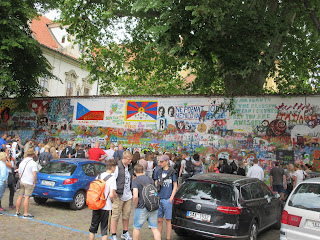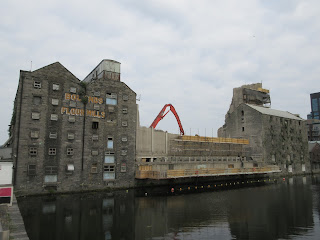 |
The mirror, in the Parker House Hotel, Boston,
where Dickens practiced A Christmas Carol
before giving public readings
|
The opening paragraph of the novella
set the scene: There is a broad discussion of how mean and cruel Scrooge is to
his fellow man. His general disposition is so unkind that even the blind man’s
dog finds no favor with him. When confronted by his nephew with his unpleasant
nature, especially given it is the Christmas season, Scrooge asks how can he
not be? He considers himself surrounded by fools and people who do not
understand the driving force of the economy. The holiday season marks a time at
which people spend lavishly money they do not have; engage in celebration,
while they have nothing to celebrate. In short, they foolishly spend their
money to make others happy. His nephew retorts, on the contrary, the season is
one in which people open their hearts and treat their neighbors charitably. He
implores Scrooge to think of people, those less fortunate, as
“fellow-passengers to the grave;” we all share the same mortality and the
existential plight of this reality. We may not have profited from those less
fortunate, but the Christmas spirit instructs us to treat them charitably
nonetheless.
A few pages later, Scrooge is
visited by two men who are seeking subscriptions for the poor: “Many thousands
are in want of common necessaries; hundreds of thousands are in want of common
comforts, sir.” His reply is telling: he queries about whether prisons and
workhouses still exist. When he is told how horrible the places are, that many
would prefer to die than be sent to those institutions, his response that those
unfortunates should die, it would have the benefit of reducing the surplus
population. The words written by Dicken, throughout his career, helped to
highlight the plight of the poor, the tragedy of child labor, and the
degradation of poor houses. It would be easy to tell ourselves that this was in
the past, part of nineteenth century Dickensian Britain; however, these
problems continue still shape our world, economies and lives.
Scrooge claims not to know of
the dismal nature of the poorhouses. It is a willful neglect. It was not his
business to concern himself with such things; his business kept him occupied to
the extent that he could not, nor did he want to, take a concern in the plight
of the poor. When his dead former business partner, Marley, appears to him, Scrooge
doubts the apparition, instead choosing to believe the facts (as relayed by his
senses) cannot be trusted. It might be a case of indigestion caused by mustard,
cheese, or an undercooked piece of potato. His rationalization of what it could
be, rather than what the facts lead us is all too familiar with the current
fascination of fake news. All too often we choose to believe what fits our heuristic
of how the world works and reject out of hand data contrary to our beliefs.
Scrooge compliments his former
partner on his business acumen; however, the ghost of Marley counters that his
actual business should have been the
welfare of humans, benevolence, and charity. Instead he, and Scrooge, chose to
focus on the trade by which they accumulated wealth. Yet, “The dealings of my
trade were but a drop of water in the comprehensive ocean of my business,”
Marley laments. It is a recurring theme in the works of Dickens, telling his
readers repeatedly that a person’s worth is not predicated on their ability to
make money. When confronted with the probable death of Tiny Tim, the Ghost of Christmas
Present reminds Scrooge of his comment that such deaths would reduce the
“surplus population.” It is a funny thing that, in modern society, we place
rhetorical emphasis on those who forego remuneration in order to help other
humans or the world in general. Yet, we privilege and celebrate those who make a
great deal of money as being wise or insightful. Where is our concern for those
less
fortunate?
The pursuit of money, while
forgetting the humanity around him, leads to the end of Scrooge’s morals,
kindness, and happiness. We can even see this as an enlightened self-interest:
karma, or what goes around, comes around. It is a point not lost on the
traveler either: a generosity of spirit yields an abundance in return. In the
opening chapter (stave), Scrooge is clearly unhappy: he offers no charity and
receives none in return. Dickens points to his avarice as the source of his
difficulties. His pursuit of money means that he loses his chance at love. The
Ghost of Christmas Past shows him how a young woman, Belle, puts an end to
their relationship because he places more emphasis on the idol money than her. She
Admonishes him, “I have seen your nobler aspirations fall off one by one, until
the master-passion, Gain, engrosses you. Have I not?” Clearly disturbed by this
vision of the past, Scrooge is forced to endure the vision of her as a grown
woman, basking in the love of her daughter and the adoration of her husband.
The path not traveled, martial contentment with Belle, is the price Scrooge
pays for his avarice.
Dickens uses the voice of the
Ghost of Christmas Present to remind is readers of the hypocrisy of Victorian
England. There was a bill introduced in parliament to close bakeries and other
entertainment venues on Christmas and Sundays, which would have deprived poor
people of a hot roast and a day of leisure. Proposed by Sir Andrew Agnew, the
Sunday Observance Bill was designed to enforce a certain amount of piety for
religious holidays; however, the burden would have fallen particularly hard on
the working class. Since bakeries were forbidden to use their ovens to bake
bread on Sundays, many allowed their ovens to be used to cook roasts for those
who did not have the means to so in their own homes. Sundays were the only day
off for most of the working poor, thus the law would deprive them of their
recreation opportunities. Scrooge asks the apparition if these moves were not
done in the name of Christmas spirit. But the ghost explains that those who
were attempting to do so were using bigotry and hatred in the name of piety to
further their interests and do not speak for the spirit of the holiday itself. Dickens
was particularly keen to advocate on behalf of the working class and their
leisure time. In a tract against the Sunday Observance Bill, he wrote: “The
idea of making a man truly moral through the ministry of constables and
sincerely religious under the influence of penalties, is worthy of the mind
which could form such a mass of monstrous absurdity.” Dickens goes on to argue that the minister who buys sports equipment for
children was doing more to make people happy, religious and moral than any
legislation could ever hope to achieve.
The use of Christmas as a
setting implies a certain religious dogma. But to think that the lessons from
Dickens applies solely to Christians would be a mistake. The lessons of
kindness and charity, of treating others well, of being patience and kind,
transcends a single religion and a specific holiday. The traveler knows that
acts of kindness while on a journey is repaid several times over.



























